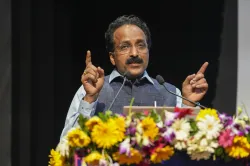The Indian Space Research Organisation, commonly known as ISRO is set to launch its first satellite, which is powered by electric propulsion in December 2024. ISRO Chairman S Somanath has announced that the Technology Demonstrator Satellite (TDS-01) will feature this advanced propulsion technology and will be launched to showcase India’s capabilities in developing lightweight yet powerful spacecraft.
Lighter satellites with electric propulsion
Electric propulsion thrusters are said to be a groundbreaking development for ISRO, as they are going to reduce the satellite's overall weight and fuel requirements. Typically, a four-tonne communication satellite carries around two tonnes of liquid fuel, which is used to maintain its orbit. However, with the new electric propulsion system (EPS), the fuel needed is drastically reduced to just 200 kg.
This makes the satellite significantly lighter while maintaining the power of a traditional four-tonne satellite.
Benefits and challenges of electric propulsion
The electric propulsion system uses propellant gases such as Argon, which are ionized using solar power. This approach is said to minimize the satellite's fuel load and the size of its peripheral systems. However, the EPS does generate lower thrust compared to chemical propulsion, which means the satellite will take longer to reach its final orbit. While chemical thrusters take about a week to reach the geostationary orbit, electric propulsion could take up to three months.
TDS-01 to demonstrate Indigenous Technology
In addition to the electric propulsion system, the TDS-01 will also feature indigenously developed travelling wave tube amplifiers (TWTAs). These components are essential for various communication and remote sensing payloads, and their successful deployment will mark a major achievement for India's space technology capabilities.
Past use- Future plans
ISRO first experimented with electric propulsion in 2017 when it used a Russian-imported system to power the GSAT-9 South Asia Satellite. This time, however, all components have been developed in India.
Chairman Somanath also provided an update on the Nasa-Isro Synthetic Aperture Radar (NISAR) satellite, stating that the radar antenna reflector has been delivered from NASA’s Jet Propulsion Laboratory and integration with the satellite is underway. The NISAR satellite is expected to launch in February 2025.
ALSO READ: Excitel’s Cable Cutter plan offers 300Mbps speed, free OTT subscriptions for less than Rs 500: Know-how
